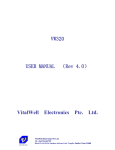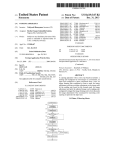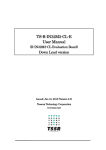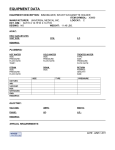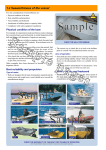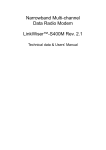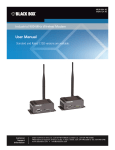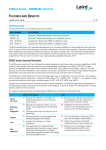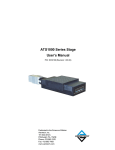Download VW320A VW321A USER MANUAL (Rev 4.1) VitalWell Electronics
Transcript
VW320A VW321A USER MANUAL (Rev 4.1) VitalWell Electronics Pte. Ltd. V italWell Electronics Pte Ltd. vital-well.com T el: +86 -0756 -3867295 Block D3, #415/416, Southern Software Park, TangJia,, ZhuHa i, Ch ina 519080 Proprietary Notice: © Copyright VitalWell Electronics Pte. Ltd., 2011 The information in this document is subject to change without notice. Company or product names mentioned in this document may be trademarks or registered trademarks of their respective companies. All rights reserved. Neither the whole nor any part of the information contained in this publication may be reproduced in any material form except with the written permission of VitalWell Electronics Pte Ltd.. This publication is intended only to assist the reader in the use of the product. VitalWell Electronics Pte Ltd. shall not be liable for any loss or damage arising from the use of any information in this publication, or any error or omission in such information, or any incorrect use of the product. Technical Support: Documentation is updated periodically. For the latest information about VitalWell Electronics Pte Ltd. products, including software upgrades and application information, please contact your local VitalWell Electronics Pte Ltd. Sales entity. VitalWell Electronics Pte Ltd. provides customer technical support using phone and/or e-mail means. For customer technical support, please contact your local VitalWell Electronics Pte Ltd. sales entity. V italWell Electronics Pte Ltd. vital-well.com T el: +86 -0756 -3867295 Block D3, #415/416, Southern Software Park, TangJia,, ZhuHa i, Ch ina 519080 INTRODUCTION The VW series Radio Modem provides the capability of a short range, reliable wireless point-to-point, point-to-multipoint and mesh network RF data communications link. The VW series modem can be used in a variety of data communications applications that require a simple to use invisible data link. The radio modem is designed to interface to a variety of host devices. These devices include computers, receipt printers, PLC’s, data loggers, SCADA devices and intelligent control systems. The serial data transferred over the radio link is not altered; the output serial data stream is the same as the input serial data stream. The radio modems provide a two-way data communications links, where each unit can accept serial data and also output serial data. The VW series radio modems are fully self-contained units, requiring only an external +5VDC (or +3.3VDC) power source to operate. The radio modules used in the radio modems have been selected to meet the requirements of unlicensed operation in the international ISM bands, and are therefore acceptable for use in many countries. Features § § § § § § § § § § § 4 operation modes: Transparent mode, Transparent secured mode, Addressed mode and Addressed secured mode Repeater supported Deep sleep mode Server-Client mode Broadcast Multi-drop mode Serial protocol format is 9600bps,8 data/1 stop/no parity. Selectable flow control of software/none. Selectable radio speed, channel and radio power. On-air data encryption, error checking and data acknowledgements. Easy configuration by AT commands. Built in configuration and diagnostic functions. This manual describes the electrical specifications and different functioning modes available on the VW series. This description will also help you to understand the principles behind the configuration registers and to use them more efficiently. V italWell Electronics Pte Ltd. vital-well.com T el: +86 -0756 -3867295 Block D3, #415/416, Southern Software Park, TangJia,, ZhuHa i, Ch ina 519080 CONTENTS CHAPTER I ELECTRICAL SPECIFICATION ……………………………1 CHAPTER II CONFIGURATION MODE ……………………………………3 II.1 Entering Configuration Mode II.2 Command Format II.3 Configuration Commands in Detail II.4 Registers Description CHAPTER III TRANSPARENT MODE III.1 Operation III.2 Examples ……………………………….……9 CHAPTER IV TRANSPARENT SECURED MODE ……………………… 10 IV.1 Operation IV.2 Examples CHAPTER V ADDRESSED MODE …………………………………………11 V.1 Operation V.2 Examples CHAPTER VI ADDRESSED SECURED MODE …………… ………… …12 VI.1 Operation VI.2 Examples CHAPTER VII ORDERING INFORMATION ………………………………...13 APPENDIX …………………………………………………………………………...14 A. Modems and boards Installation: Principles and cautions B. Register setting tips and examples B.1. Configuration list file B.2. Turn on Software flow control (Xon/Xoff) B.3. Changing Operation Mode B.4. A typical point-point configuration using Addressed Mode B.5. A typical Server-Client configuration using Addressed Mode B.6. A typical Hyper-terminal setting (Xon/Xoff enable) V italWell Electronics Pte Ltd. vital-well.com T el: +86 -0756 -3867295 Block D3, #415/416, Southern Software Park, TangJia,, ZhuHa i, Ch ina 519080 CHAPTER I ELECTRICAL SPECIFICATION I.1 General Specifications 1)Supply Voltage:+5V or +3.3V (±10%) 2)Supply Current: < 120mA(VW320A), <1A (VW321A) 3)Voltage level at I/O:+3.3V TTL( +5V compatible) 4):Serial Interface Characteristics (RS232) i. Baud rate: 1200bps ~ 115.2kbps, ( 9600bps, 8N1, Default) 5)RF Characteristics: i. Frequency band:ISM 433/868/915MHz ii. Channels: 100 iii. RF rate: 1.2kbps, 2.4kbpa, 4.8kbps, 9.6kbps, 19.2kps, 38.4kbps, 76.8kbps, 115.2kbps iv. Max RF transmitter power VW320A: +20dB (100mW) VW321A: +30dB (1W) v. Sensitivity:-121dB (1.2kbps), -108dB(38.4kbps) vi. Typical link range (outdoor) : VW320A : >1000m @9600bps, L.O.S VW321A: > 2000m @9600bps, L.O.S 6) Ready to Tx/Rx after power on reset: 150ms max I.2 Dimension 232TTL: 1) (L X W X H): 41mm X 23mm X 5mm (PCB assembly, exclude connector) 2) Interface: 10pin; 2.0mm header RS232C, RS485: 1) (L X W X H): 70mm x 50mm x 20mm (Metal casing) 2) Interface: terminal block (screw) USB: (L X W X H): 83mm x 83mm x 25mm (Metal casing) V it al We ll E l ectr on ics P t e Ltd www.v it al-well .com -1- I.3 Interface Specifications Interface : 232 TTL The signal voltage level of VW320 is 3.3V TTL level at the interface, with +5V compatible. Signal Definitions: Pin No. 1 2 3 4 Signal Name GND VCC (+5V) RXD (RS232,TTL) TXD (RS232, TTL) Pin No. 6 7 8 9 5 IO0 (RS485 T/R) 10 Signal Name IO1 (board ready) IO2 IO3 IO4 (Sleep/WOR Ctl) Boot loader /EN Interface : RS232C Signal Definitions: GND, +5V, RXD, TXD Interface : RS485 Signal Definitions: GND, +5V, A, B, T/R Interface : USB After installing a driver, it will create a virtual serial port on the PC. All applications, which designed for serial ports, will be able to work well with the modules. E.g., It allows the PC to use a normal hyper-terminal application to communicate with the module. Connector: USB B-type connector V it al We ll E l ectr on ics P t e Ltd www.v it al-well .com -2- I.4 Typical Connections 1) 232TTL / RS232C (connections at Pin1~4 only) 1 (GND) 2 (+5V) 3(RXD) 4(TXD) VW320A-232T, 232C VW321A-232T, 232C 1(GND) 2 (+5V) 3(RXD) 4(TXD) Host 2) VW320A-485, VW321A0485 VW320A-485 VW321A-485 1 (GND) 2 (+5V) 3( A) 4( B) V it al We ll E l ectr on ics P t e Ltd 1 (GND) 2 (+5V) 3(A) 4(B) www.v it al-well .com -3- CHAPTER II CONFIGURATION MODE For fast and easy configure the modems to suit various application, the user is recommended to use our Config_Panel program which can be downloaded from our web to modify the settings. When in filed changes needed, the user can follow the notes below. This section describes the configuration and test commands supported by the radio modem. In most cases, once the configuration is set it will not need to be changed. Configuration is performed using a serial terminal, or appropriate communication application. All commands and command values accepted by the radio modem are described in this section; any entries other than those listed here results in an invalid command or argument error message. The first step to configuring the Radio Modem is to put it in Configuration Mode… II.1 Entering Configuration Mode A series of three consecutively typed characters, called an escape sequence, forces the radio modem to exit data transfer mode and enter the modem configuration mode. While in Configuration Mode, you can communicate directly with the radio modem using a number of specific commands to configure and test the radio modem. The escape sequence is factory set to ‘+++’ (No carriage return key is followed). A pause length of which is called the escape guard time (about 1s) must be completed both before and after when escape sequence is entered. These three '+' characters must not be sent as one continued frame. The delay between any 2 characters must be between 20ms~200ms for the (‘+++’) sequence. This prevents the radio modem from interpreting the escape sequence as data and the vice versa. The guard time must also be met when the Radio Modem is initially powered up. Configuration changes are stored permanently in non-volatile memory within the Radio Modem. Exiting Configuration Mode and returning back to data transfer mode is accomplished by typing “ATO” at the command prompt. This will force a soft reset of the Radio Modem resulting in any configuration changes taking effect. II.2 Command Format VW modem’s parameters are set through the use of AT type commands sent on the serial link. V it al We ll E l ectr on ics P t e Ltd www.v it al-well .com -4- 'AT' commands complies with Hayes protocol used in PSTN modem standards. This ‘AT’ protocol is used to configure the modem parameters, based on the following principles : A data frame always begins with the two ASCII ’AT’ characters, standing for ‘ATtention’, _ Commands are coded over one or several characters and may include additional data _ A given command always ends up with a < CR> Carriage Return AT Command Additional data <CR> Note: The delay between 2 characters of the same command must be less than 30 seconds All alphabetical characters typed in configuration command mode are converted to upper case before being interpreted by the configurator. Thus commands can be typed using either upper or lower case. Despite its similarity to standard telecommunication modem, it remains a radio link modem and is consequently fitted with some particular and specific ‘AT’ commands proper to radio transmission (I.e. communication channel, radio rate...). V it al We ll E l ectr on ics P t e Ltd www.v it al-well .com -5- II.3 Configuration Commands in Detail Command Description Operating mode Configuration Mode Activation +++ ‘+++’ Command gives an instant access to the modem’s parameters configuration mode (AT mode). ‘+++’ Command should be entered one by one. The time between two ‘+’ must be between 50ms ~200ms. Answer: > Communication mode activation ATO ‘ATO’ command gives an instant access to the modem’s Operating mode. ‘ATO’ command is used to get out of Configuration Mode. And Parameters will be saved to on-chip non-volatile memory. Answer: Good Bye! Communication mode activation ATX ‘ATX’ command gives an instant access to the modem’s Operating mode. ‘ATX’ command is used to get out of Configuration Mode. And Parameters will NOT be saved to on-chip non-volatile memory, and only changed in RAM. After reset, it will restore the previous saved parameters. Answer: Good Bye! V it al We ll E l ectr on ics P t e Ltd www.v it al-well .com -6- Command Description Register Handling ‘AT/V’ command displays the modem’s firmware version number similar as follows: AT/V AT/L ATSn=m Or VW4432A-4 V2.0 B/N: 20110727 > ‘AT/L’ command displays a dynamic and clear status of all relevant registers of the modem with the following categories: _ Serial link, _ Radio, _ Operation Mode, _ Network ‘ATSn=m’ or ‘ATSn=m.k’ command configures register number n with the value m (or m.k, if 2 Bytes), e.g. ATS100=32<CR> enters the value ‘32’ in the register S100; ATS120=192.168 enter the value ‘192.168’ in the register S120. The value of m & k is between 0~255. ATSn=m.k Answer: > or ??(CR) > if the configuration is not valid V it al We ll E l ectr on ics P t e Ltd www.v it al-well .com -7- II.4 Registers Description The parameters to be configured via Configuration mode are stored in modem’s memory registers, called S registers. Those registers are always listed as follows: _ S10x registers correspond to the serial parameters, _ S110x registers correspond to the radio parameters, _ S12x registers correspond to the general/ network operation parameters, The standard registers and their use are shown in the next table. V it al We ll E l ectr on ics P t e Ltd www.v it al-well .com -8- II.4.1 Registers Description Table Serial Link Access Registers R/W S100 Name Serial Link FIFO size Description Indicates the maximum frames size that will be given to the Modem. When this size is reached, the data in the FIFO will be immediately sent out via RF link (If flow control is enable, a Xoff code will be sent out from the modem). Value Range: 1~50, Default: 50 R/W R/W S101 S102 Serial Link Flow Control Serial Link Time Out Indicates flow control type: _ '0': None (default) _ '1': Software: Xon/Xoff, Indicates the value of the time-out on the serial link ( time out counts on bytes lapsed on the current baudrate). E.g: at serial baudrate 9600bps, a value ‘5’ means a 5bytes transmit time on 9600bps, that is: about 5ms. This is used: when the serial FIFO is not full, after this time out, the data in the FIFO will be sent out via RF link. Value Range: 3~255 Default: 3 Sleep Mode Control: (for 232TTL version) 0 – Disable (Default), module always active 1,2,3 – Enable R/W S103 Sleep Mode Control If S103=1, sleep enabled, wakeup active by IO4 If S103=2, sleep enabled, wakeup active by WOR If S103=3, sleep enabled, wakeup active by WOR or IO4 And: I/O1(output) will be used to indicate the working status: I/O1 = 0: indicate a active status I/O1 = 1: indicate a power down mode See more details on appendix c. R/W S104 Serial Baud Rate V it al We ll E l ectr on ics P t e Ltd Serial Baud Rate 0, 1, 2, 3, 4, 5, 6, 7 -> 1200bps, 2400bps, 4800bps, 9600bps,19.2kbps, 38.4kbps, 57.6kbps, 115.2kbps www.v it al-well .com -9- Radio Access Registers R/W S110 R/W S111 R/W S112 R/W S115 Name Description Set the speed on the Radio: _ '0': 1200 Bits/s, _ '1': 2400 Bits/s, Radio Baud _ '2': 4800 Bits/s, _ '3': 9600 Bits/s, (Default) Rate _ '4': 19200 Bits/s, _ '5': 38400 Bits/s, _ '6': 76800 Bits/s, _ ‘'7': 115200 Bits/s, _ '8': 256000 Bits/s (VW110A, VW2500A only) Number of the radio channel in use. Radio Range: 0~100 Channel Default: 0 Power of the Radio. For VW320A: 0, 1, 2, 3, 4, 5, 6, 7 Radio Power è +1dB, +2dB, +5dB, +8dB, +11dB, +14dB, +17dB, +20dB For VW321A: 0, 1, 2, 3, 4, 5, +18dB, +20dB, +21dB, +23dB, +25dB, +30dB RSSI Value show/hide _ '0': hide (default) _ '1': show When set to show, when receiving a message, the modem will echo the RSSI value of the received message to the host. Please refer to the Si4432 datasheet for the RSSI value Vs input power Setting W.O.R timer when register S103 =2 or 3 R/W S116 WOR Timer Step is 200ms Exp: when S116=10, means the board will auto wakeup every 2s to listen a wakeup beacon signal. If no, then auto back to sleep mode; if yes, will pull IO1 to low. See more details on appendix c. V it al We ll E l ectr on ics P t e Ltd www.v it al-well .com - 10 - Operation & Network Access Registers Name Description Network ID in 2 Bytes. R/W S120 Network ID E.g.: ATS120=192.168 will set the network ID to 192.168 R/W S121 Device ID Device ID (Used for Addressed Mode or Addressed Secured Mode). R/W S122 Default Destination Device ID Default Destination Device ID (Used for Addressed Mode or Addressed Secured Mode). If Destination ID is not provided in the payload, data will sent to this address. R/W S123 Group ID Group ID (Used only for Transparent Mode or Transparent Secured Mode). All and only devices with the same cluster id (together with the network id) will be linkable. Operation Mode: R/W S124 Operation Mode _’0’ Transparent Mode (default) _ ‘1’ Transparent Secured Mode _ ‘2’ Addressed Mode _ ‘3’ Addressed Secured Mode _ ‘10’ Testing mode, in this mode, the module will automatically transmit a pre-defined string once a second. It can be used to test the linkage range without a host. _’20’ : test mode 2, used for pattern test. During this mode, the modem will Tx a 20byte’s 0x00, 0x01, 0x00, 0x01,…. Data stream once a second. _’21’: test mode 3 (Tx un-modulated carrier signal) _’22’: test mode 4 (Tx GFSK-modulated spectrum signal) R/W S125 Number of Retries Number of recoveries counts in case of radio conflicts (Used for Addressed Secured /Transparent Secured Mode). Default: 3 Indicates whether Address at the header. Bit 0 for TX, bit 1 for RX. ( For addressed mode only) R/W S126 Address at the Header (TX & RX) Bit 0: _ '0': Data will be sent to default address (Register S123); V it al We ll E l ectr on ics P t e Ltd www.v it al-well .com - 11 - _ '1': Decode the target address from the header when TX. Bit 1: _ ’0’: when receive, forward the payload without address. _ ’1’: when receive, add the message’s source address at the header together with payload (default) E.g.: When S126=1or 3, the‘10=ABCD’ inputs, will sent data ‘ABCD’ to address 10; when S126=2 or 3, the output “2=ABCD” means the data come from address 2. Indicates the acknowledgment handling method (Used for Addressed/Transparent Secured Mode). (Only the lower 4bits in this byte will be R/W. the upper 4 bits is used by system to indicate the RF acknowledgment status). R Or S127 Echo back Ack to host R/W _ '0': No (Default), OK or fail signal is not sent to Host _ '1': OK or fail signal will be sent to host By default, in case of problems, the modem will retry automatically for the numbers (which set by register S125), but doesn’t assert the signals to host. If enable, after each successful transmission, a Synchronize byte (0x16) will be sent out; if after retry still fail, a NAK byte (0x15) will be sent to the host. R/W S128 Node Type R/W S129 Repeater Enable Node Type: ‘0’: Normal node (not intent to route a message) ’1’: Repeater node (This is a repeater, and will route any message it received) Repeater Enable control: ‘0’ : Disable ‘1’: Enable If S129 = 1, the TX package will automatically routed to & via the repeater(address defined by S130) R/W S130 Repeater Address Repeater Address: If S129 =1, this register will set the desired repeater’s address. All Tx package will be send to this node first, and the repeater will automatically route the package to the desired destination. V it al We ll E l ectr on ics P t e Ltd www.v it al-well .com - 12 - CHAPTER III TRANSPARENT MODE The transparent mode is the default communication mode, based on a null-modem cable emulation. Basically, the modems in transparent mode is equivalent to a halfduplex module and reproduces the half-duplex function of a RS-485 , RS-232 or RS422 cable. This mode can be used as Point to Point or Point to Multi-point with all the modems receiving the messages sent by any modem. III.1 Operation Radio modems in transparent mode behave like wired serial links. Therefore, radio modems automatically transmit every serial data received on their radio link, and also transmit all radio information received on their serial link. The transparent mode can be operated for both point-to-point and multipoint links. The software flow control (Xon/Xoff) can be enabling for this mode if the user want to send a large block data in this mode. However, no flow control on the radio link is performed by the radio modems in transparent mode. Therefore, the data control must then be carried out by software applications used by various protocols such as ProfiBus, ModBus, etc… Consequently, the latency time is reduced to its minimum as the modem no needs wait to check the acknowledgment byte. Any unit, with the same network ID and group ID, configured in transparent mode will receive every radio data flowing on the same communication channel, i.e. on the same frequency. III.2 Examples - Configuration with AT commands User Modem User Modem User Modem User Modem User Modem +++ > ATS120=192.168<CR> > ATS123=120<CR> > ATS124=0<CR> > ATO<CR> Good Bye! V it al We ll E l ectr on ics P t e Ltd // Switch to Configuration mode // Set network ID to 192.168 // set cluster id to 120 // Transparent mode selection,0 // Switch to operating mode www.v it al-well .com - 13 - CHAPTER IV TRANSPARENT SECURED MODE In order to confirm the good quality of transmitted data frames and to avoid data loss, data frame control between radio modems are added to the transparent mode, so that each data transfer is verified. IV.1 Operation Transparent secured mode’s purpose is to offer an optimal radio link quality and to provide transparent mode with the necessary security in case frame control would not be included within the user’s application software. The risk of data loss is therefore much weaker. Moreover, a flow control, Xon/Xoff can be enabling to be performed on the serial link in order to warn the user that the data buffer is saturating. The receiving unit analyses this data frame and checks its consistency, When the data frame is received correctly, the receiver transmits an Acknowledgement back to the transmitter, and delivers the received data frame to its serial link. In case the reception is not satisfying, no acknowledgement is received by the transmitter. The transmitter then repeats the data frame transmission after a random delay. The number of iterations can be configured via S126 register. Transparent secured mode shall be operated for point-to-point communications only. At serial port level, the statements of whether the data frame has been transmitted or not can be asserted to the user by enable the bit in S128 register. IV.2 Examples - Configuration with AT commands User Modem User Modem User Modem User Modem User Modem +++ > ATS120=192.168<CR> > ATS123=120<CR> > ATS124=1<CR> > ATO<CR> Good Bye! V it al We ll E l ectr on ics P t e Ltd // Switch to Configuration mode // Set network ID to 192.168 // set cluster id to 120 // Transparent Secure mode // Switch to operating mode www.v it al-well .com - 14 - CHAPTER V ADDRESSED MODE The addressed mode is similar to a multipoint mode. All modems can communicate with each other by addressing each frame to one of them. V.1 Operation Addressed mode’s purpose is to offer an optimal radio link performance providing the multipoint access of the transparent mode. Compared to the transparent mode, the addressed mode therefore includes the additional feature to address each data frame to a specific modem. When enabled, the modem can identifie the clients with a specific number added at the beginning of each data frame. For example: "1=Hello" sends the data frame "Hello" to Client 1. The address header can be omitted by setting the address_at_the_header control register S127 to 0 (ATS127=0). Then all of the data frames will be sent to the default address (register S123). This is useful when in a server-client configuration; all clients set the default address to their server address. For example, when S127=0, S123=1, “Hello” sends the data frame “Hello” to server 1. Receiver client recognizes the Client transmitting modem by decoding the data frame and send the data frame to its serial link. When enabled, the modems can inform the hosts with a specific number added at the beginning of each data frame received. For example: "2=Hello" indicates that data frame "Hello" comes from Client 2. The software flow control (Xon/Xoff) can be enabled (ATS101=1) on its serial link. V.2 User Modem User Modem User Modem User Modem User Modem User Modem User Modem Examples - Configuration with AT commands +++ // Switch to Configuration mode > ATS120=192.168<CR> // Set network ID to 192.168 > ATS121=10<CR> // set device id to 10 > ATS122=11<CR> // set default destination id to 11 > ATS124=2<CR> // Addressed mode > ATS126=0<CR> // no address header, data will be sent to the default > ATO<CR> // Switch to operating mode Good Bye! V it al We ll E l ectr on ics P t e Ltd www.v it al-well .com - 15 - CHAPTER VI ADDRESSED SECURED MODE The addressed secured mode is similar to a addressed mode, but with acknowledgment handling on the radio. VI.1 Operation Addressed secured mode’s purpose is to offer an optimal radio link quality. Compared to the addressed mode, the addressed secured mode therefore includes the additional feature to retransmit the data frame in case of radio collisions. All the address handling method is identified with the addressed mode. And, the radio acknowledgment handling method is identified with the transparent secured mode. The software flow control (Xon/Xoff) can be enabled (ATS101=1) on its serial link. VI.2 User Modem User Modem User Modem User Modem User Modem User Modem User Modem User Modem User Modem Examples - Configuration with AT commands +++ // Switch to Configuration mode > ATS120=192.168<CR> // Set network ID to 192.168 > ATS121=10<CR> // set device id to 10 > ATS122=11<CR> // set default destination id to 11 > ATS124=3<CR> // Addressed Secured mode > ATS125=3<CR> // set the retries=3 in case of collision > ATS126=0<CR> // no address header, data will be sent to the default > ATS127=0<CR> // no echo back host for the acknowledge > ATO<CR> // Switch to operating mode Good Bye! V it al We ll E l ectr on ics P t e Ltd www.v it al-well .com - 16 - CHAPTER VII ORDERING INFORMATION Ordering Code: Code VW320A-232T-X Description VW320A, Interface: 232 TTL VW320A -232C-X VW320A, Interface: RS232C VW320A -485-X VW320A, Interface: RS485 VW320A -USB-X VW320A, Interface: USB VW321A-232T-X VW321A, Interface: 232 TTL VW321A -232C-X VW321A, Interface: RS232C VW321A -485-X VW321A, Interface: RS485 VW321A -USB-X VW321A, Interface: USB Where: X = 4: Frequency band at 433MHz ISM X = 8: Frequency band at 868MHz ISM X = 9: Frequency band at 915MHz ISM V it al We ll E l ectr on ics P t e Ltd www.v it al-well .com - 17 - APPENDIX A. Modems and boards Installation: Principles and cautions _ The radio environment should be closely studied prior to any installation in order to determine whether and where the installation will be optimal. _ The modems should be located as high and as free as possible so that a line of sight propagation is established between modems to achieve a better radio link. _ The modem should not be surrounded by metallic masses because of the disturbances caused by a reflection phenomena. _ The electrical disturbances can come from various sources and should be avoided: _ Engines _ High current devices _ Power relays _ Transformers _ Etc… _ Vibrations and/or shocks can also be source of disturbances. It is therefore advised to mount the modems on silent-blocks in order to stabilize it whenever necessary. V it al We ll E l ectr on ics P t e Ltd www.v it al-well .com - 18 - B. Register setting tips and examples B.1. Configuration list file You can put a typical setting list into .txt file. After commanding the modem into configuration mode, you can send this file to modem via serial link (In hyper terminal, this is done by choosing: Transfer -> Send Text File…). Then later you can just only adjust 1 or 2 registers’ settings depending on the requirement. Or, you may just want to confirm the settings by enter “AT/L” to have a setting’s list. After everything is confirmed, you can enter “ATO” and press the “Enter” key to leave the configuration mode to operation mode. Here is a typical setting list file for a transparent mode: <Setting.txt> ATS100=60 ATS101=1 ATS102=5 ATS110=3 ATS111=0 ATS112=3 ATS120=192.168 ATS121=100 ATS122=200 ATS123=127 ATS124=0 ATS125=3 ATS126=0 ATS127=0 (End) B.2. Turn on Software flow control (Xon/Xoff) ATS101=1 B.3. Changing Operation Mode ATS124=m (m=0,1,2,3) V it al We ll E l ectr on ics P t e Ltd www.v it al-well .com - 19 - B.4. A typical point-point configuration using Addressed Mode <Client1> ATS100=60 ATS101=1 ATS102=5 ATS110=3 ATS111=0 ATS112=3 ATS120=192.168 ATS121=100 ATS122=200 ATS123=127 ATS124=2 ATS125=3 ATS126=0 ATS127=0 // you can turn off Xon/Xoff by ATS101=0 // device ID // default destination id // Addressed Mode //no address at the header <Client2> ATS100=60 ATS101=1 ATS102=5 ATS110=3 ATS111=0 ATS112=3 ATS120=192.168 ATS121=200 ATS122=100 ATS123=127 ATS124=2 ATS125=3 ATS126=0 ATS127=0 V it al We ll E l ectr on ics P t e Ltd // you can turn off Xon/Xoff by ATS101=0 // device ID // default destination id // Addressed Mode //no address at the header www.v it al-well .com - 20 - B.5. A typical Server-Client configuration using Addressed Mode <Server> ATS100=60 ATS101=1 ATS102=5 ATS110=3 ATS111=0 ATS112=3 ATS120=192.168 ATS121=10 ATS122=200 ATS123=127 ATS124=2 ATS125=3 ATS126=3 ATS127=0 // you can turn off Xon/Xoff by ATS101=0 // device ID, server ID=10 // default destination id, dummy for server // Addressed Mode //client address at the header, for server <Client 1> ATS100=60 ATS101=1 … ATS120=192.168 ATS121=1 ATS122=10 … ATS124=2 … ATS126=0 ATS127=0 // you can turn off Xon/Xoff by ATS101=0 // device ID, client id=1 // default destination id, the server ID // Addressed Mode //no address at the header, default to/from server; for client <Client 2> ATS100=60 ATS101=1 … ATS120=192.168 ATS121=2 ATS122=10 … ATS124=2 … ATS126=0 ATS127=0 // you can turn off Xon/Xoff by ATS101=0 // device ID, client id=2 // default destination id, the server ID // Addressed Mode //no address at the header, default to/from server; for client On server, "1=Hello" sends the data frame "Hello" to Client 1. "2=Hello" sends the data frame "Hello" to Client 2. On each client, “Hello” sends the data frame “Hello” to server (ID=10). V it al We ll E l ectr on ics P t e Ltd www.v it al-well .com - 21 - B.6. A typical Hyper-terminal setting (Xon/Xoff enable) V it al We ll E l ectr on ics P t e Ltd www.v it al-well .com - 22 - C. Sleep mode notes This operation is for VW320A-232T only. VW320 series are built-in with configurable sleep modes to suit various applications. When go to sleep mode, the board can be waked up by 1) I/O pin (S103 = 1, sleep mode 1) 2) W.O.R timer only (S103 = 2,, sleep mode 2) 3) Both (S103 = 3, sleep mode 3) IO4 (pin 9) is used to wakeup board when pin wakeup mode is enabled (S103 =1 or 3). A falling edge on IO4 will wake up board from sleep mode. IO4 should be kept low to keep the board be in active mode. A rising edge will put the board back to sleep mode. VW320 have another wakeup event: WOR functions. When WOR sleep mode enabled ( WOR timer be set at S116 @200ms step ), the board will auto wakeup by a WOR timer overflow, and will auto listen a mater’s WOR beacon signal. If yes, the board will info the external MCU by pull down IO1, and is kept active at least for 0.2s. When the external MCU received the IO1 low signal, and need the board be kept active to complete some task, it should pull IO4 to low. A rising edge on IO4 will put the board back to sleep mode, and WOR timer will restart; if no response from the external MCU after pull IO1 to low, the board will auto go to sleep mode after 200ms, and also the WOR will restart. When in sleep mode, IO1 will be push to high. How to wake up a WOR enabled slave? The master should set S103=0. Then a falling edge on IO4 will trigger a WOR wakeup beacon event. The master will continues send out a series beacon (time is defined by S116). The value of S116 of master should >= slaves’ S116 to ensure a successful wakeup. V it al We ll E l ectr on ics P t e Ltd www.v it al-well .com - 23 - D. Boot loader notes (VW320A series) VW320A is equipped with a boot loader when shipped out from factory. It allow the firmware be upgraded after receive the board. Users can request to alter the default firmware to suit their special application after receiving the board. Depending on the request, we, Vitalwell will evaluate it and do the changes accordingly. The modified firmware will be sent out by email. The boot loader is active by keep pin10 to low during power up. When boot loader is active, the on board LED will flash fast to indicate a ready to receive new firmware state. The firmware is send to board via a serial COM connection. PC application for the boot loader is available. Firmware uploader’s interface V it al We ll E l ectr on ics P t e Ltd www.v it al-well .com - 24 - Document History a) b) c) d) e) f) Rev 1.0: Rev 2.0: Rev 2.2: Rev 2.3: Rev 2.4: Rev 2.5: g) h) i) k) Rev 2.5A: Rev 2.5B: Rev 3.0: Rev 3.1: l) Rev 3.2: j) Rev 4.0: k) Rev 4.1 Initial release, for VW1203A Add VW1100A & VW2500A Add ordering information Add FEC control register for VW1100A & VW2500A Add VW1205A i) Add sleep mode( - 232T, S103) & testing mode(S124) ii) Signal at Pin 9 changed. iii) Repeater function (S128 ~S130) Correct some typing error. Description changes on register S102. Add VW4432A change notes for register S112, Add register S104; other minor changes 1) Change notes for Register S124 2) Add notes for register S115 (RSSI value show/hide control) 3) add notes for time of ready to Tx/Rx after P.O.R 1) separate manual for VW320 2) Change notes for register S103 (sleep control) 3)Add Register S116 (W.O.R timer control) 4) notes for boot loader. 5) new ATX command added (page 5) 1) add notes for VW321A V it al We ll E l ectr on ics P t e Ltd www.v it al-well .com - 25 - Vita lWell Electronics Pte Ltd. Tel: +86-0756-3867295 Block D3, #415/416, Southern Software Park, TangJia,, ZhuHai, China 519080 vital-well.com






























